Contemporary Employee Relations: Conflict Analysis and Resolution
VerifiedAdded on 2020/12/30
|12
|3907
|266
Report
AI Summary
This report provides an analysis of contemporary employee relations, focusing on the concept of conflict, different perspectives surrounding conflicts (unitary and pluralist), and the role of natural justice in grievance procedures and conflict resolution. The report uses Cathay Pacific as a case study, examining how employee relations are practiced and the impact of conflicts on daily operations. It defines conflict, explores its various types and causes, and discusses measures to resolve it effectively. Furthermore, the report differentiates between the unitary and pluralist perspectives on conflict, highlighting their assumptions about organizational structure, management-employee relationships, and the role of trade unions. The importance of natural justice in resolving grievances is also discussed. The report is a comprehensive overview of employee relations and conflict management strategies.
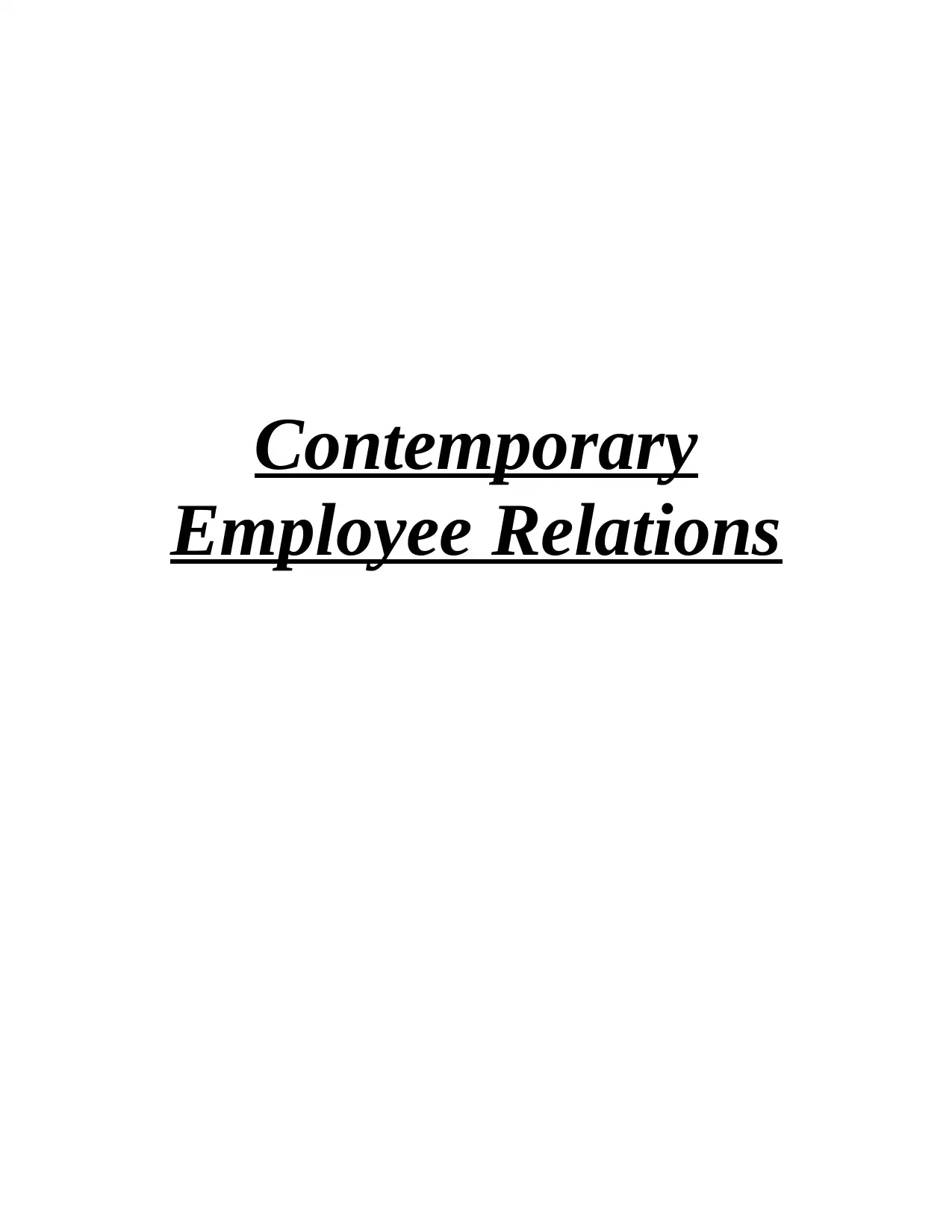
Contemporary
Employee Relations
Employee Relations
Paraphrase This Document
Need a fresh take? Get an instant paraphrase of this document with our AI Paraphraser
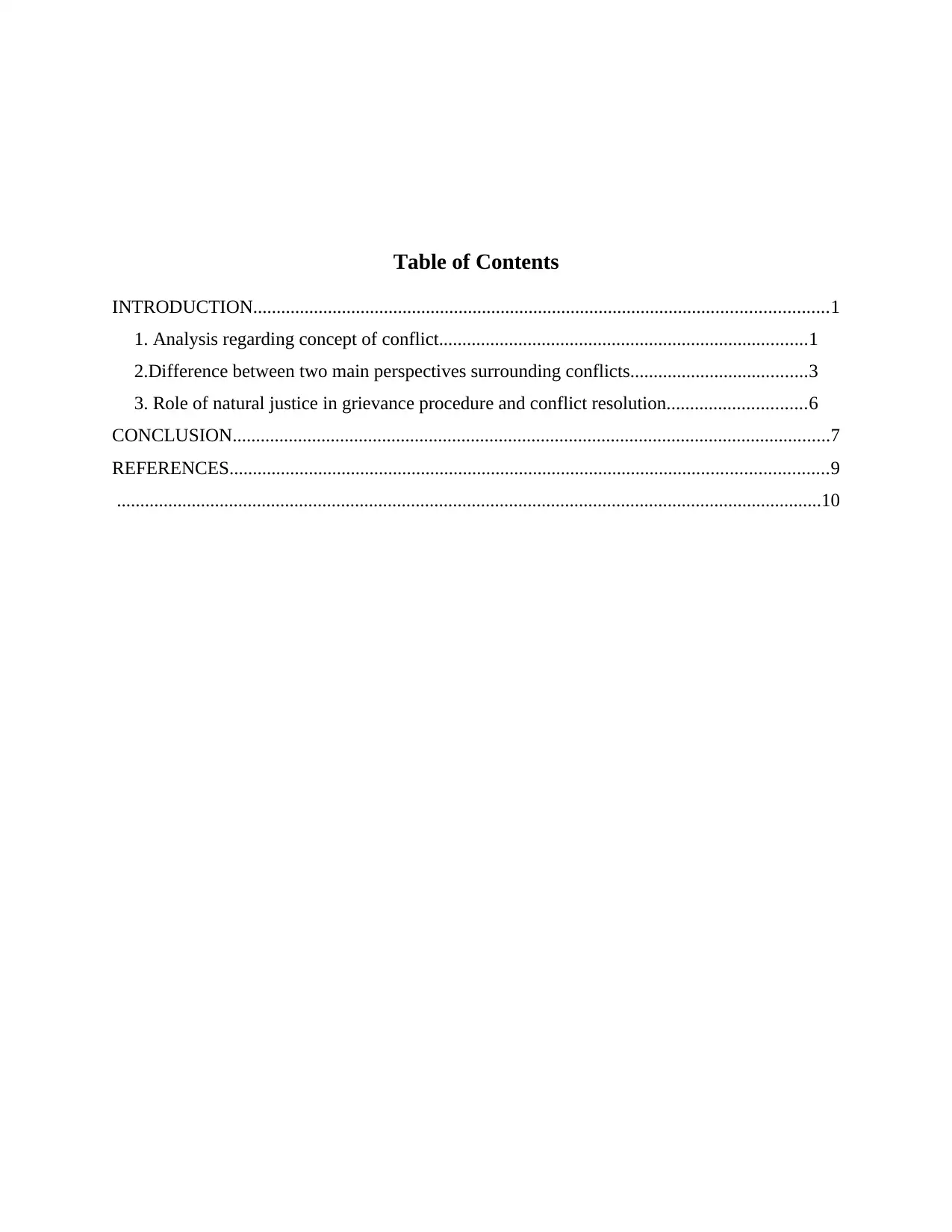
Table of Contents
INTRODUCTION...........................................................................................................................1
1. Analysis regarding concept of conflict...............................................................................1
2.Difference between two main perspectives surrounding conflicts......................................3
3. Role of natural justice in grievance procedure and conflict resolution..............................6
CONCLUSION................................................................................................................................7
REFERENCES................................................................................................................................9
.......................................................................................................................................................10
INTRODUCTION...........................................................................................................................1
1. Analysis regarding concept of conflict...............................................................................1
2.Difference between two main perspectives surrounding conflicts......................................3
3. Role of natural justice in grievance procedure and conflict resolution..............................6
CONCLUSION................................................................................................................................7
REFERENCES................................................................................................................................9
.......................................................................................................................................................10
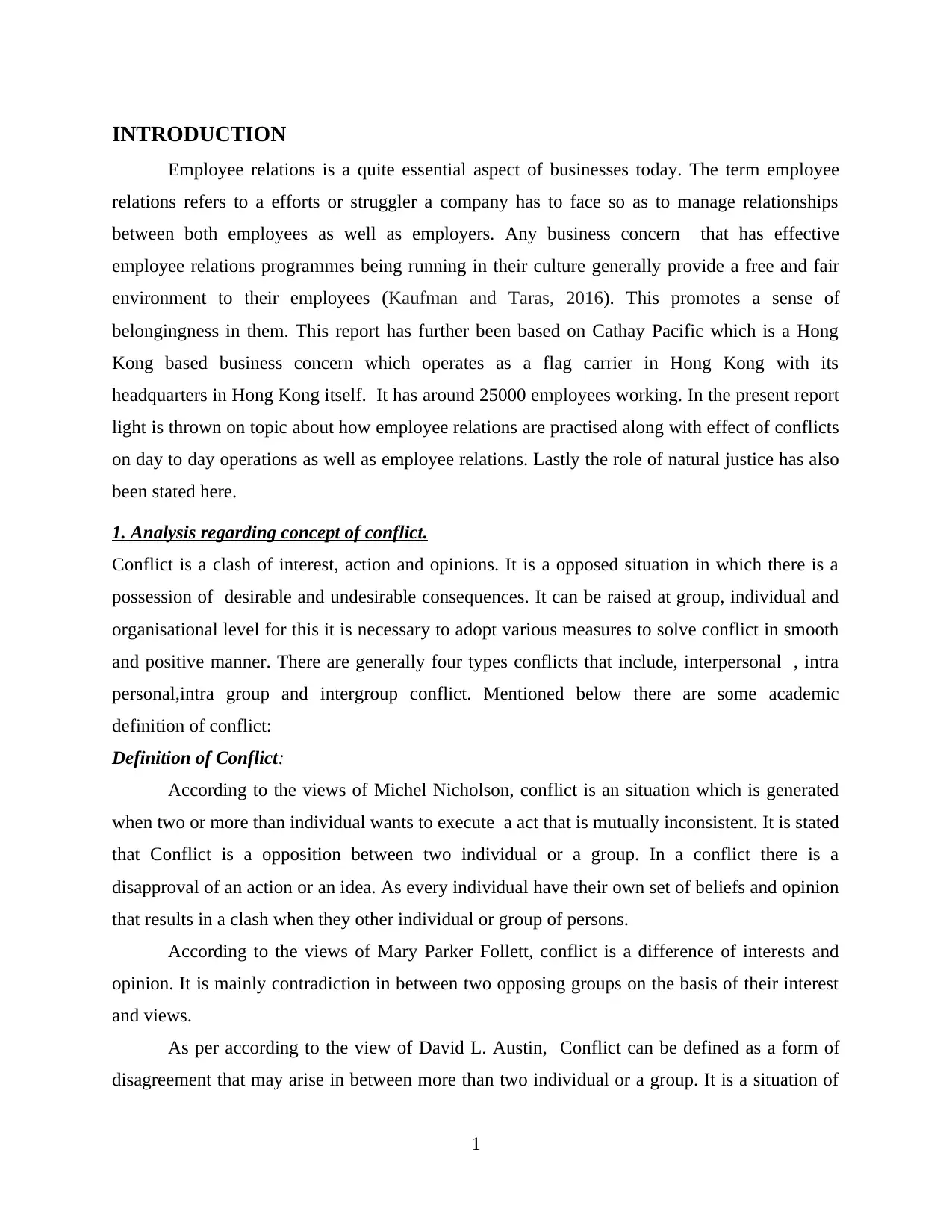
INTRODUCTION
Employee relations is a quite essential aspect of businesses today. The term employee
relations refers to a efforts or struggler a company has to face so as to manage relationships
between both employees as well as employers. Any business concern that has effective
employee relations programmes being running in their culture generally provide a free and fair
environment to their employees (Kaufman and Taras, 2016). This promotes a sense of
belongingness in them. This report has further been based on Cathay Pacific which is a Hong
Kong based business concern which operates as a flag carrier in Hong Kong with its
headquarters in Hong Kong itself. It has around 25000 employees working. In the present report
light is thrown on topic about how employee relations are practised along with effect of conflicts
on day to day operations as well as employee relations. Lastly the role of natural justice has also
been stated here.
1. Analysis regarding concept of conflict.
Conflict is a clash of interest, action and opinions. It is a opposed situation in which there is a
possession of desirable and undesirable consequences. It can be raised at group, individual and
organisational level for this it is necessary to adopt various measures to solve conflict in smooth
and positive manner. There are generally four types conflicts that include, interpersonal , intra
personal,intra group and intergroup conflict. Mentioned below there are some academic
definition of conflict:
Definition of Conflict:
According to the views of Michel Nicholson, conflict is an situation which is generated
when two or more than individual wants to execute a act that is mutually inconsistent. It is stated
that Conflict is a opposition between two individual or a group. In a conflict there is a
disapproval of an action or an idea. As every individual have their own set of beliefs and opinion
that results in a clash when they other individual or group of persons.
According to the views of Mary Parker Follett, conflict is a difference of interests and
opinion. It is mainly contradiction in between two opposing groups on the basis of their interest
and views.
As per according to the view of David L. Austin, Conflict can be defined as a form of
disagreement that may arise in between more than two individual or a group. It is a situation of
1
Employee relations is a quite essential aspect of businesses today. The term employee
relations refers to a efforts or struggler a company has to face so as to manage relationships
between both employees as well as employers. Any business concern that has effective
employee relations programmes being running in their culture generally provide a free and fair
environment to their employees (Kaufman and Taras, 2016). This promotes a sense of
belongingness in them. This report has further been based on Cathay Pacific which is a Hong
Kong based business concern which operates as a flag carrier in Hong Kong with its
headquarters in Hong Kong itself. It has around 25000 employees working. In the present report
light is thrown on topic about how employee relations are practised along with effect of conflicts
on day to day operations as well as employee relations. Lastly the role of natural justice has also
been stated here.
1. Analysis regarding concept of conflict.
Conflict is a clash of interest, action and opinions. It is a opposed situation in which there is a
possession of desirable and undesirable consequences. It can be raised at group, individual and
organisational level for this it is necessary to adopt various measures to solve conflict in smooth
and positive manner. There are generally four types conflicts that include, interpersonal , intra
personal,intra group and intergroup conflict. Mentioned below there are some academic
definition of conflict:
Definition of Conflict:
According to the views of Michel Nicholson, conflict is an situation which is generated
when two or more than individual wants to execute a act that is mutually inconsistent. It is stated
that Conflict is a opposition between two individual or a group. In a conflict there is a
disapproval of an action or an idea. As every individual have their own set of beliefs and opinion
that results in a clash when they other individual or group of persons.
According to the views of Mary Parker Follett, conflict is a difference of interests and
opinion. It is mainly contradiction in between two opposing groups on the basis of their interest
and views.
As per according to the view of David L. Austin, Conflict can be defined as a form of
disagreement that may arise in between more than two individual or a group. It is a situation of
1
⊘ This is a preview!⊘
Do you want full access?
Subscribe today to unlock all pages.

Trusted by 1+ million students worldwide
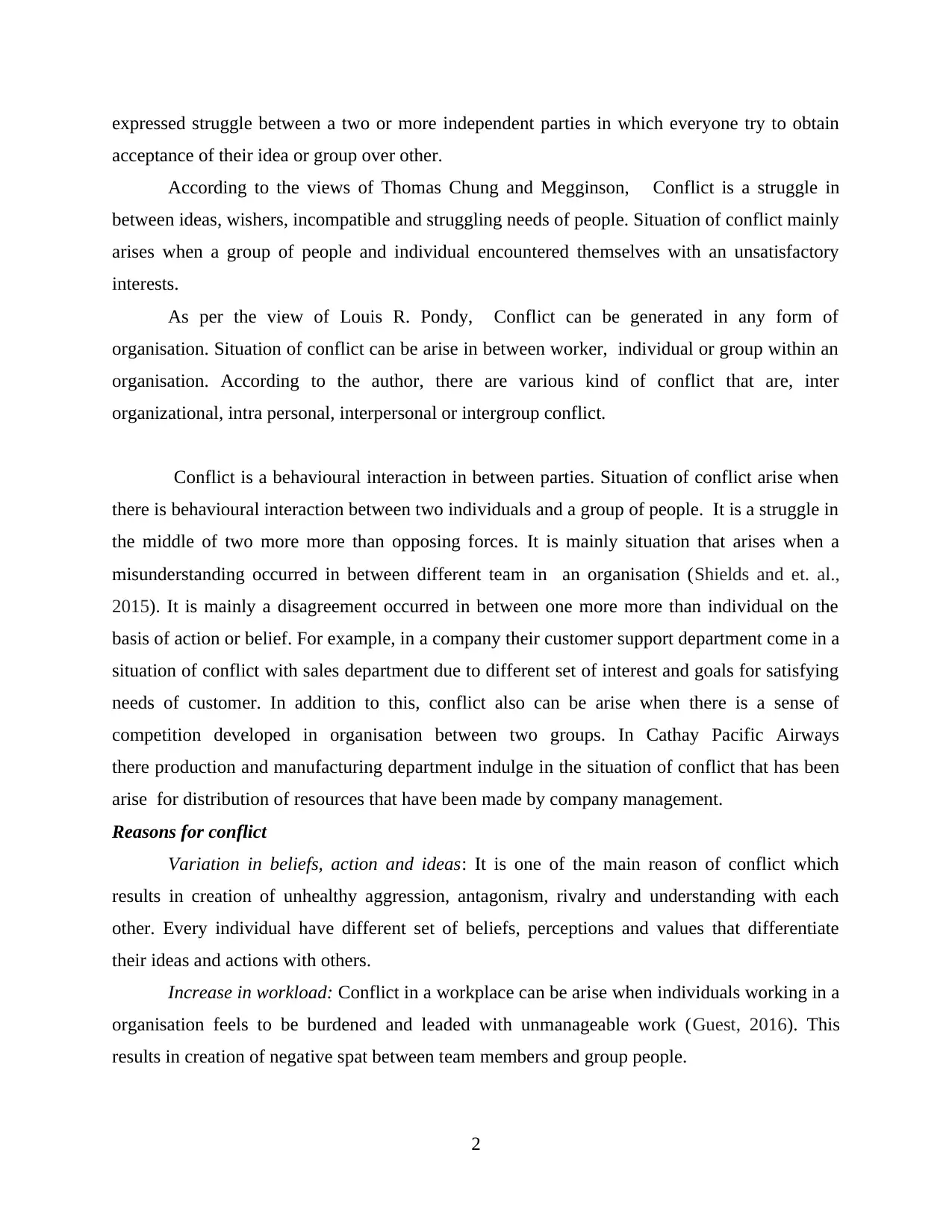
expressed struggle between a two or more independent parties in which everyone try to obtain
acceptance of their idea or group over other.
According to the views of Thomas Chung and Megginson, Conflict is a struggle in
between ideas, wishers, incompatible and struggling needs of people. Situation of conflict mainly
arises when a group of people and individual encountered themselves with an unsatisfactory
interests.
As per the view of Louis R. Pondy, Conflict can be generated in any form of
organisation. Situation of conflict can be arise in between worker, individual or group within an
organisation. According to the author, there are various kind of conflict that are, inter
organizational, intra personal, interpersonal or intergroup conflict.
Conflict is a behavioural interaction in between parties. Situation of conflict arise when
there is behavioural interaction between two individuals and a group of people. It is a struggle in
the middle of two more more than opposing forces. It is mainly situation that arises when a
misunderstanding occurred in between different team in an organisation (Shields and et. al.,
2015). It is mainly a disagreement occurred in between one more more than individual on the
basis of action or belief. For example, in a company their customer support department come in a
situation of conflict with sales department due to different set of interest and goals for satisfying
needs of customer. In addition to this, conflict also can be arise when there is a sense of
competition developed in organisation between two groups. In Cathay Pacific Airways
there production and manufacturing department indulge in the situation of conflict that has been
arise for distribution of resources that have been made by company management.
Reasons for conflict
Variation in beliefs, action and ideas: It is one of the main reason of conflict which
results in creation of unhealthy aggression, antagonism, rivalry and understanding with each
other. Every individual have different set of beliefs, perceptions and values that differentiate
their ideas and actions with others.
Increase in workload: Conflict in a workplace can be arise when individuals working in a
organisation feels to be burdened and leaded with unmanageable work (Guest, 2016). This
results in creation of negative spat between team members and group people.
2
acceptance of their idea or group over other.
According to the views of Thomas Chung and Megginson, Conflict is a struggle in
between ideas, wishers, incompatible and struggling needs of people. Situation of conflict mainly
arises when a group of people and individual encountered themselves with an unsatisfactory
interests.
As per the view of Louis R. Pondy, Conflict can be generated in any form of
organisation. Situation of conflict can be arise in between worker, individual or group within an
organisation. According to the author, there are various kind of conflict that are, inter
organizational, intra personal, interpersonal or intergroup conflict.
Conflict is a behavioural interaction in between parties. Situation of conflict arise when
there is behavioural interaction between two individuals and a group of people. It is a struggle in
the middle of two more more than opposing forces. It is mainly situation that arises when a
misunderstanding occurred in between different team in an organisation (Shields and et. al.,
2015). It is mainly a disagreement occurred in between one more more than individual on the
basis of action or belief. For example, in a company their customer support department come in a
situation of conflict with sales department due to different set of interest and goals for satisfying
needs of customer. In addition to this, conflict also can be arise when there is a sense of
competition developed in organisation between two groups. In Cathay Pacific Airways
there production and manufacturing department indulge in the situation of conflict that has been
arise for distribution of resources that have been made by company management.
Reasons for conflict
Variation in beliefs, action and ideas: It is one of the main reason of conflict which
results in creation of unhealthy aggression, antagonism, rivalry and understanding with each
other. Every individual have different set of beliefs, perceptions and values that differentiate
their ideas and actions with others.
Increase in workload: Conflict in a workplace can be arise when individuals working in a
organisation feels to be burdened and leaded with unmanageable work (Guest, 2016). This
results in creation of negative spat between team members and group people.
2
Paraphrase This Document
Need a fresh take? Get an instant paraphrase of this document with our AI Paraphraser
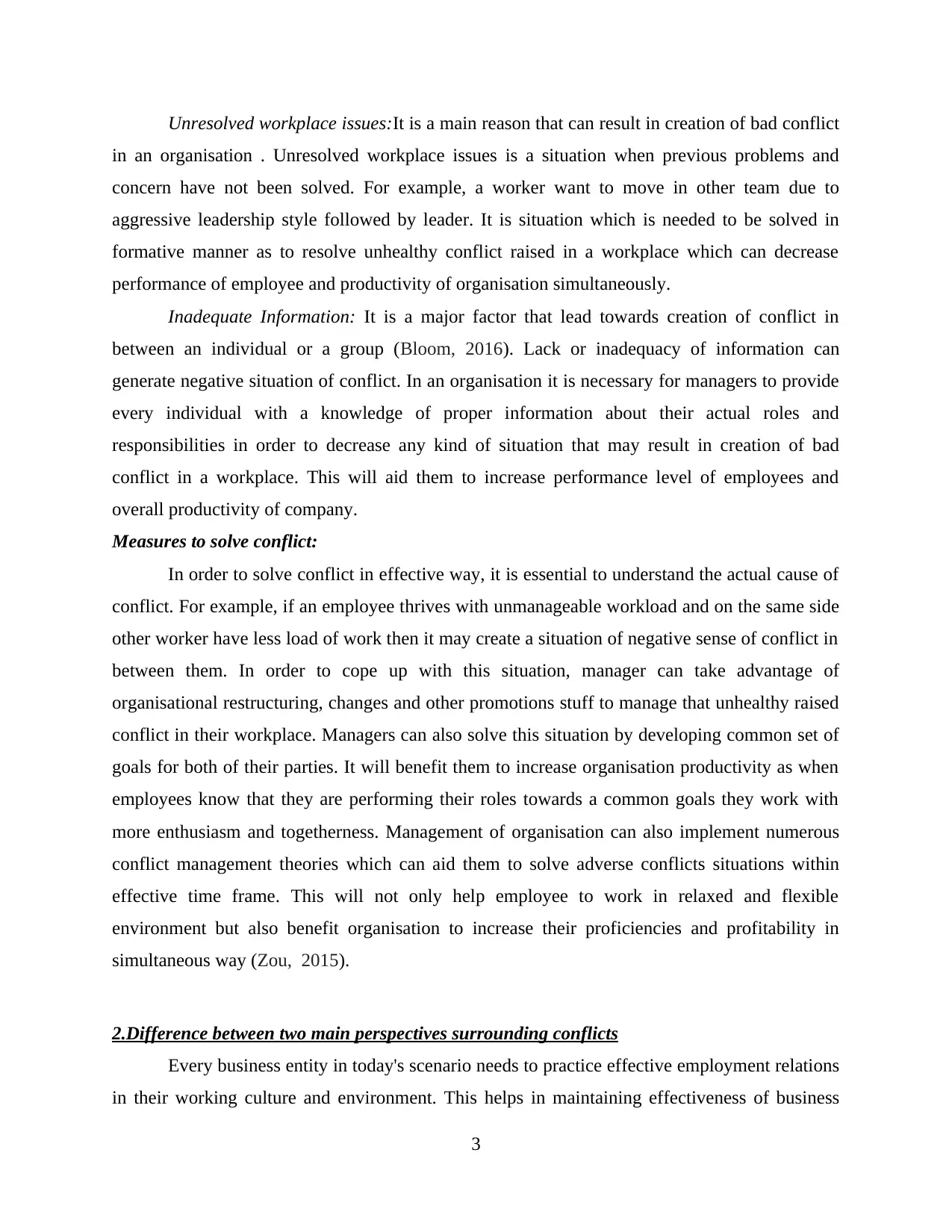
Unresolved workplace issues:It is a main reason that can result in creation of bad conflict
in an organisation . Unresolved workplace issues is a situation when previous problems and
concern have not been solved. For example, a worker want to move in other team due to
aggressive leadership style followed by leader. It is situation which is needed to be solved in
formative manner as to resolve unhealthy conflict raised in a workplace which can decrease
performance of employee and productivity of organisation simultaneously.
Inadequate Information: It is a major factor that lead towards creation of conflict in
between an individual or a group (Bloom, 2016). Lack or inadequacy of information can
generate negative situation of conflict. In an organisation it is necessary for managers to provide
every individual with a knowledge of proper information about their actual roles and
responsibilities in order to decrease any kind of situation that may result in creation of bad
conflict in a workplace. This will aid them to increase performance level of employees and
overall productivity of company.
Measures to solve conflict:
In order to solve conflict in effective way, it is essential to understand the actual cause of
conflict. For example, if an employee thrives with unmanageable workload and on the same side
other worker have less load of work then it may create a situation of negative sense of conflict in
between them. In order to cope up with this situation, manager can take advantage of
organisational restructuring, changes and other promotions stuff to manage that unhealthy raised
conflict in their workplace. Managers can also solve this situation by developing common set of
goals for both of their parties. It will benefit them to increase organisation productivity as when
employees know that they are performing their roles towards a common goals they work with
more enthusiasm and togetherness. Management of organisation can also implement numerous
conflict management theories which can aid them to solve adverse conflicts situations within
effective time frame. This will not only help employee to work in relaxed and flexible
environment but also benefit organisation to increase their proficiencies and profitability in
simultaneous way (Zou, 2015).
2.Difference between two main perspectives surrounding conflicts
Every business entity in today's scenario needs to practice effective employment relations
in their working culture and environment. This helps in maintaining effectiveness of business
3
in an organisation . Unresolved workplace issues is a situation when previous problems and
concern have not been solved. For example, a worker want to move in other team due to
aggressive leadership style followed by leader. It is situation which is needed to be solved in
formative manner as to resolve unhealthy conflict raised in a workplace which can decrease
performance of employee and productivity of organisation simultaneously.
Inadequate Information: It is a major factor that lead towards creation of conflict in
between an individual or a group (Bloom, 2016). Lack or inadequacy of information can
generate negative situation of conflict. In an organisation it is necessary for managers to provide
every individual with a knowledge of proper information about their actual roles and
responsibilities in order to decrease any kind of situation that may result in creation of bad
conflict in a workplace. This will aid them to increase performance level of employees and
overall productivity of company.
Measures to solve conflict:
In order to solve conflict in effective way, it is essential to understand the actual cause of
conflict. For example, if an employee thrives with unmanageable workload and on the same side
other worker have less load of work then it may create a situation of negative sense of conflict in
between them. In order to cope up with this situation, manager can take advantage of
organisational restructuring, changes and other promotions stuff to manage that unhealthy raised
conflict in their workplace. Managers can also solve this situation by developing common set of
goals for both of their parties. It will benefit them to increase organisation productivity as when
employees know that they are performing their roles towards a common goals they work with
more enthusiasm and togetherness. Management of organisation can also implement numerous
conflict management theories which can aid them to solve adverse conflicts situations within
effective time frame. This will not only help employee to work in relaxed and flexible
environment but also benefit organisation to increase their proficiencies and profitability in
simultaneous way (Zou, 2015).
2.Difference between two main perspectives surrounding conflicts
Every business entity in today's scenario needs to practice effective employment relations
in their working culture and environment. This helps in maintaining effectiveness of business
3
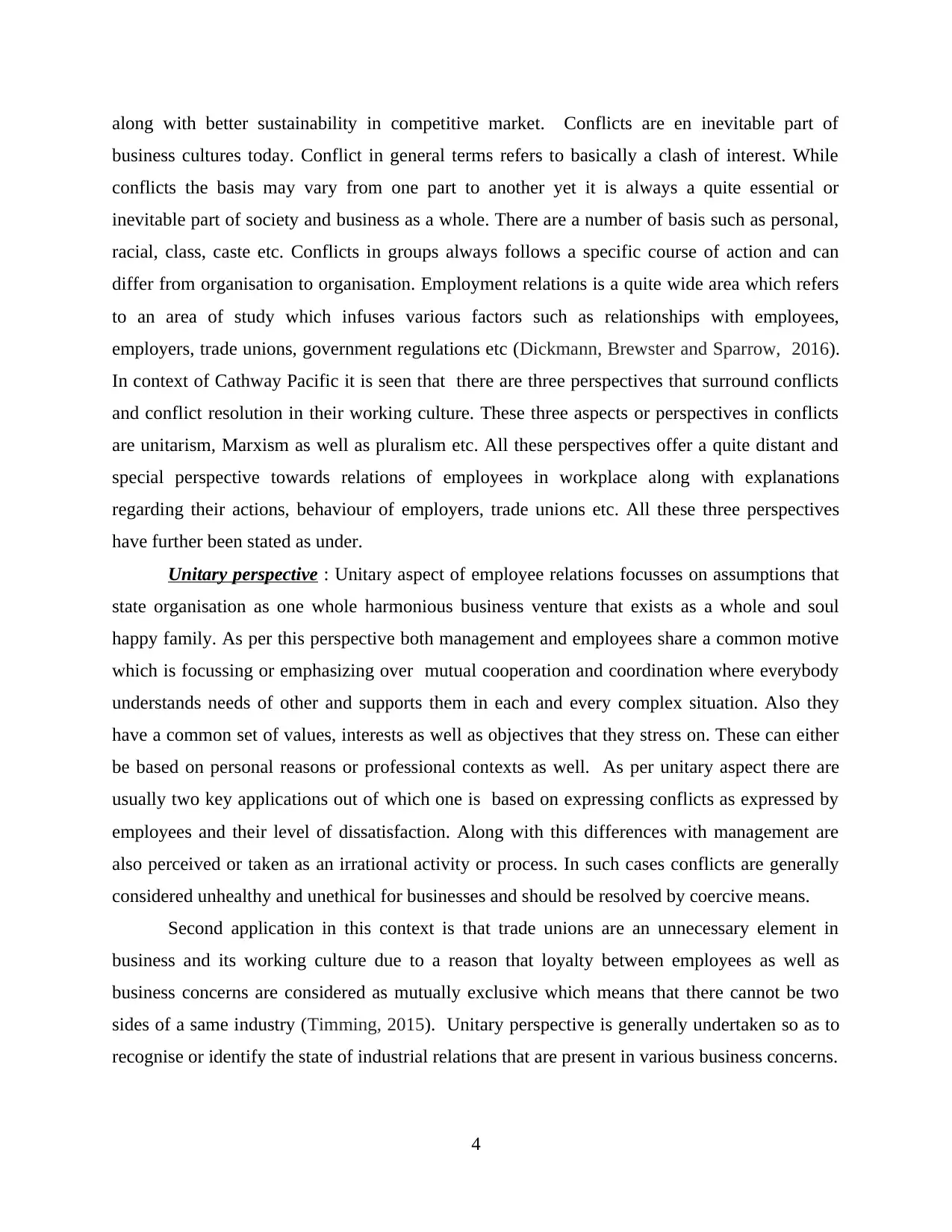
along with better sustainability in competitive market. Conflicts are en inevitable part of
business cultures today. Conflict in general terms refers to basically a clash of interest. While
conflicts the basis may vary from one part to another yet it is always a quite essential or
inevitable part of society and business as a whole. There are a number of basis such as personal,
racial, class, caste etc. Conflicts in groups always follows a specific course of action and can
differ from organisation to organisation. Employment relations is a quite wide area which refers
to an area of study which infuses various factors such as relationships with employees,
employers, trade unions, government regulations etc (Dickmann, Brewster and Sparrow, 2016).
In context of Cathway Pacific it is seen that there are three perspectives that surround conflicts
and conflict resolution in their working culture. These three aspects or perspectives in conflicts
are unitarism, Marxism as well as pluralism etc. All these perspectives offer a quite distant and
special perspective towards relations of employees in workplace along with explanations
regarding their actions, behaviour of employers, trade unions etc. All these three perspectives
have further been stated as under.
Unitary perspective : Unitary aspect of employee relations focusses on assumptions that
state organisation as one whole harmonious business venture that exists as a whole and soul
happy family. As per this perspective both management and employees share a common motive
which is focussing or emphasizing over mutual cooperation and coordination where everybody
understands needs of other and supports them in each and every complex situation. Also they
have a common set of values, interests as well as objectives that they stress on. These can either
be based on personal reasons or professional contexts as well. As per unitary aspect there are
usually two key applications out of which one is based on expressing conflicts as expressed by
employees and their level of dissatisfaction. Along with this differences with management are
also perceived or taken as an irrational activity or process. In such cases conflicts are generally
considered unhealthy and unethical for businesses and should be resolved by coercive means.
Second application in this context is that trade unions are an unnecessary element in
business and its working culture due to a reason that loyalty between employees as well as
business concerns are considered as mutually exclusive which means that there cannot be two
sides of a same industry (Timming, 2015). Unitary perspective is generally undertaken so as to
recognise or identify the state of industrial relations that are present in various business concerns.
4
business cultures today. Conflict in general terms refers to basically a clash of interest. While
conflicts the basis may vary from one part to another yet it is always a quite essential or
inevitable part of society and business as a whole. There are a number of basis such as personal,
racial, class, caste etc. Conflicts in groups always follows a specific course of action and can
differ from organisation to organisation. Employment relations is a quite wide area which refers
to an area of study which infuses various factors such as relationships with employees,
employers, trade unions, government regulations etc (Dickmann, Brewster and Sparrow, 2016).
In context of Cathway Pacific it is seen that there are three perspectives that surround conflicts
and conflict resolution in their working culture. These three aspects or perspectives in conflicts
are unitarism, Marxism as well as pluralism etc. All these perspectives offer a quite distant and
special perspective towards relations of employees in workplace along with explanations
regarding their actions, behaviour of employers, trade unions etc. All these three perspectives
have further been stated as under.
Unitary perspective : Unitary aspect of employee relations focusses on assumptions that
state organisation as one whole harmonious business venture that exists as a whole and soul
happy family. As per this perspective both management and employees share a common motive
which is focussing or emphasizing over mutual cooperation and coordination where everybody
understands needs of other and supports them in each and every complex situation. Also they
have a common set of values, interests as well as objectives that they stress on. These can either
be based on personal reasons or professional contexts as well. As per unitary aspect there are
usually two key applications out of which one is based on expressing conflicts as expressed by
employees and their level of dissatisfaction. Along with this differences with management are
also perceived or taken as an irrational activity or process. In such cases conflicts are generally
considered unhealthy and unethical for businesses and should be resolved by coercive means.
Second application in this context is that trade unions are an unnecessary element in
business and its working culture due to a reason that loyalty between employees as well as
business concerns are considered as mutually exclusive which means that there cannot be two
sides of a same industry (Timming, 2015). Unitary perspective is generally undertaken so as to
recognise or identify the state of industrial relations that are present in various business concerns.
4
⊘ This is a preview!⊘
Do you want full access?
Subscribe today to unlock all pages.

Trusted by 1+ million students worldwide
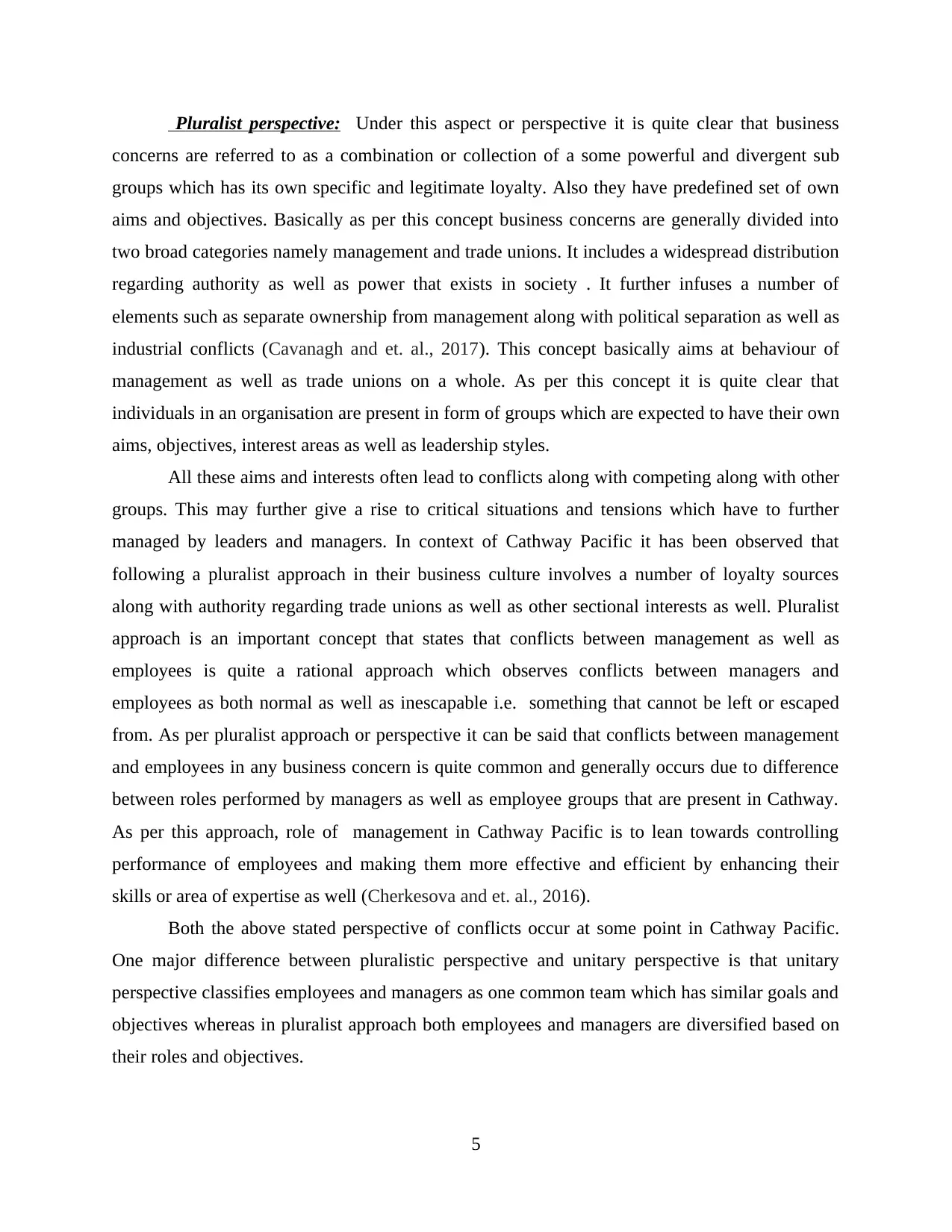
Pluralist perspective: Under this aspect or perspective it is quite clear that business
concerns are referred to as a combination or collection of a some powerful and divergent sub
groups which has its own specific and legitimate loyalty. Also they have predefined set of own
aims and objectives. Basically as per this concept business concerns are generally divided into
two broad categories namely management and trade unions. It includes a widespread distribution
regarding authority as well as power that exists in society . It further infuses a number of
elements such as separate ownership from management along with political separation as well as
industrial conflicts (Cavanagh and et. al., 2017). This concept basically aims at behaviour of
management as well as trade unions on a whole. As per this concept it is quite clear that
individuals in an organisation are present in form of groups which are expected to have their own
aims, objectives, interest areas as well as leadership styles.
All these aims and interests often lead to conflicts along with competing along with other
groups. This may further give a rise to critical situations and tensions which have to further
managed by leaders and managers. In context of Cathway Pacific it has been observed that
following a pluralist approach in their business culture involves a number of loyalty sources
along with authority regarding trade unions as well as other sectional interests as well. Pluralist
approach is an important concept that states that conflicts between management as well as
employees is quite a rational approach which observes conflicts between managers and
employees as both normal as well as inescapable i.e. something that cannot be left or escaped
from. As per pluralist approach or perspective it can be said that conflicts between management
and employees in any business concern is quite common and generally occurs due to difference
between roles performed by managers as well as employee groups that are present in Cathway.
As per this approach, role of management in Cathway Pacific is to lean towards controlling
performance of employees and making them more effective and efficient by enhancing their
skills or area of expertise as well (Cherkesova and et. al., 2016).
Both the above stated perspective of conflicts occur at some point in Cathway Pacific.
One major difference between pluralistic perspective and unitary perspective is that unitary
perspective classifies employees and managers as one common team which has similar goals and
objectives whereas in pluralist approach both employees and managers are diversified based on
their roles and objectives.
5
concerns are referred to as a combination or collection of a some powerful and divergent sub
groups which has its own specific and legitimate loyalty. Also they have predefined set of own
aims and objectives. Basically as per this concept business concerns are generally divided into
two broad categories namely management and trade unions. It includes a widespread distribution
regarding authority as well as power that exists in society . It further infuses a number of
elements such as separate ownership from management along with political separation as well as
industrial conflicts (Cavanagh and et. al., 2017). This concept basically aims at behaviour of
management as well as trade unions on a whole. As per this concept it is quite clear that
individuals in an organisation are present in form of groups which are expected to have their own
aims, objectives, interest areas as well as leadership styles.
All these aims and interests often lead to conflicts along with competing along with other
groups. This may further give a rise to critical situations and tensions which have to further
managed by leaders and managers. In context of Cathway Pacific it has been observed that
following a pluralist approach in their business culture involves a number of loyalty sources
along with authority regarding trade unions as well as other sectional interests as well. Pluralist
approach is an important concept that states that conflicts between management as well as
employees is quite a rational approach which observes conflicts between managers and
employees as both normal as well as inescapable i.e. something that cannot be left or escaped
from. As per pluralist approach or perspective it can be said that conflicts between management
and employees in any business concern is quite common and generally occurs due to difference
between roles performed by managers as well as employee groups that are present in Cathway.
As per this approach, role of management in Cathway Pacific is to lean towards controlling
performance of employees and making them more effective and efficient by enhancing their
skills or area of expertise as well (Cherkesova and et. al., 2016).
Both the above stated perspective of conflicts occur at some point in Cathway Pacific.
One major difference between pluralistic perspective and unitary perspective is that unitary
perspective classifies employees and managers as one common team which has similar goals and
objectives whereas in pluralist approach both employees and managers are diversified based on
their roles and objectives.
5
Paraphrase This Document
Need a fresh take? Get an instant paraphrase of this document with our AI Paraphraser
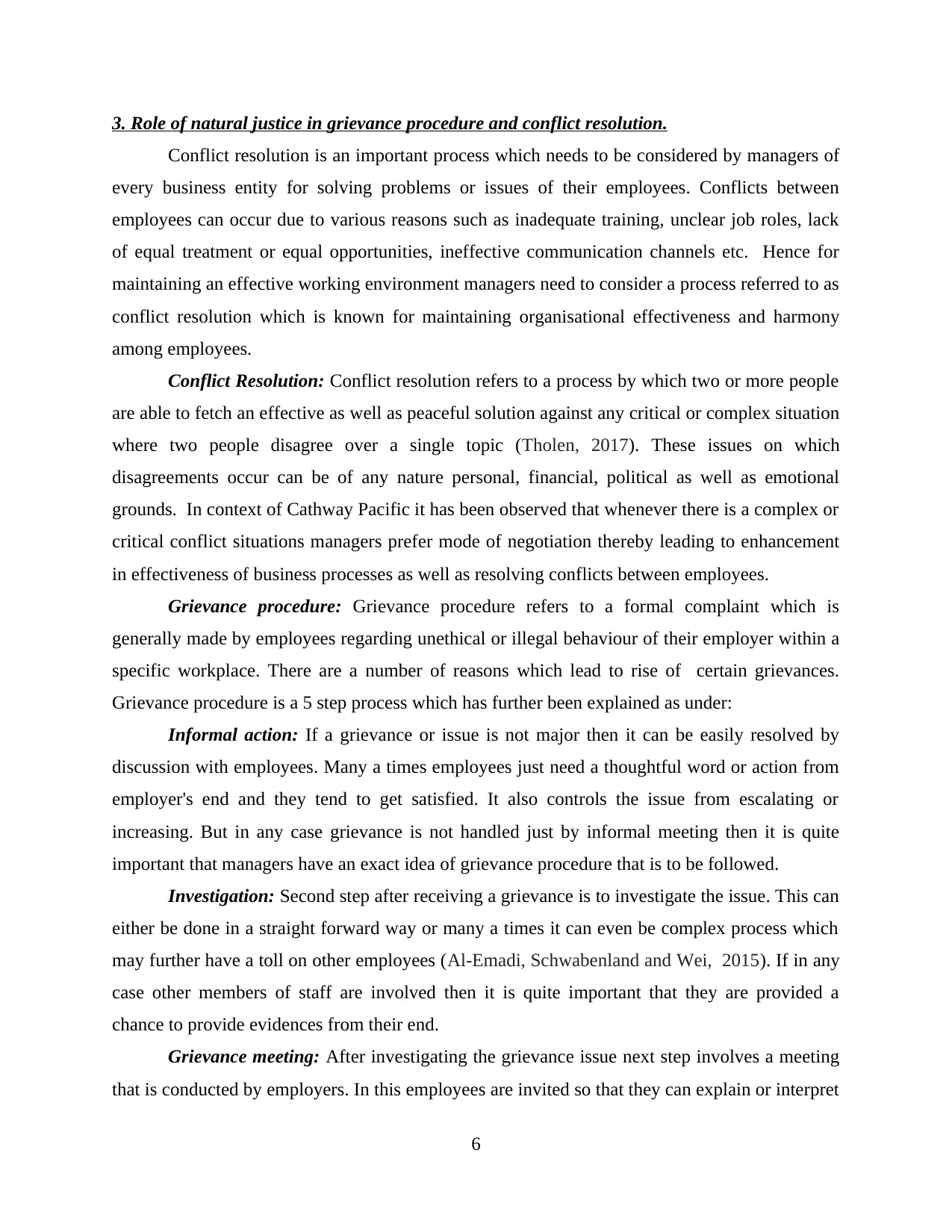
3. Role of natural justice in grievance procedure and conflict resolution.
Conflict resolution is an important process which needs to be considered by managers of
every business entity for solving problems or issues of their employees. Conflicts between
employees can occur due to various reasons such as inadequate training, unclear job roles, lack
of equal treatment or equal opportunities, ineffective communication channels etc. Hence for
maintaining an effective working environment managers need to consider a process referred to as
conflict resolution which is known for maintaining organisational effectiveness and harmony
among employees.
Conflict Resolution: Conflict resolution refers to a process by which two or more people
are able to fetch an effective as well as peaceful solution against any critical or complex situation
where two people disagree over a single topic (Tholen, 2017). These issues on which
disagreements occur can be of any nature personal, financial, political as well as emotional
grounds. In context of Cathway Pacific it has been observed that whenever there is a complex or
critical conflict situations managers prefer mode of negotiation thereby leading to enhancement
in effectiveness of business processes as well as resolving conflicts between employees.
Grievance procedure: Grievance procedure refers to a formal complaint which is
generally made by employees regarding unethical or illegal behaviour of their employer within a
specific workplace. There are a number of reasons which lead to rise of certain grievances.
Grievance procedure is a 5 step process which has further been explained as under:
Informal action: If a grievance or issue is not major then it can be easily resolved by
discussion with employees. Many a times employees just need a thoughtful word or action from
employer's end and they tend to get satisfied. It also controls the issue from escalating or
increasing. But in any case grievance is not handled just by informal meeting then it is quite
important that managers have an exact idea of grievance procedure that is to be followed.
Investigation: Second step after receiving a grievance is to investigate the issue. This can
either be done in a straight forward way or many a times it can even be complex process which
may further have a toll on other employees (Al-Emadi, Schwabenland and Wei, 2015). If in any
case other members of staff are involved then it is quite important that they are provided a
chance to provide evidences from their end.
Grievance meeting: After investigating the grievance issue next step involves a meeting
that is conducted by employers. In this employees are invited so that they can explain or interpret
6
Conflict resolution is an important process which needs to be considered by managers of
every business entity for solving problems or issues of their employees. Conflicts between
employees can occur due to various reasons such as inadequate training, unclear job roles, lack
of equal treatment or equal opportunities, ineffective communication channels etc. Hence for
maintaining an effective working environment managers need to consider a process referred to as
conflict resolution which is known for maintaining organisational effectiveness and harmony
among employees.
Conflict Resolution: Conflict resolution refers to a process by which two or more people
are able to fetch an effective as well as peaceful solution against any critical or complex situation
where two people disagree over a single topic (Tholen, 2017). These issues on which
disagreements occur can be of any nature personal, financial, political as well as emotional
grounds. In context of Cathway Pacific it has been observed that whenever there is a complex or
critical conflict situations managers prefer mode of negotiation thereby leading to enhancement
in effectiveness of business processes as well as resolving conflicts between employees.
Grievance procedure: Grievance procedure refers to a formal complaint which is
generally made by employees regarding unethical or illegal behaviour of their employer within a
specific workplace. There are a number of reasons which lead to rise of certain grievances.
Grievance procedure is a 5 step process which has further been explained as under:
Informal action: If a grievance or issue is not major then it can be easily resolved by
discussion with employees. Many a times employees just need a thoughtful word or action from
employer's end and they tend to get satisfied. It also controls the issue from escalating or
increasing. But in any case grievance is not handled just by informal meeting then it is quite
important that managers have an exact idea of grievance procedure that is to be followed.
Investigation: Second step after receiving a grievance is to investigate the issue. This can
either be done in a straight forward way or many a times it can even be complex process which
may further have a toll on other employees (Al-Emadi, Schwabenland and Wei, 2015). If in any
case other members of staff are involved then it is quite important that they are provided a
chance to provide evidences from their end.
Grievance meeting: After investigating the grievance issue next step involves a meeting
that is conducted by employers. In this employees are invited so that they can explain or interpret
6
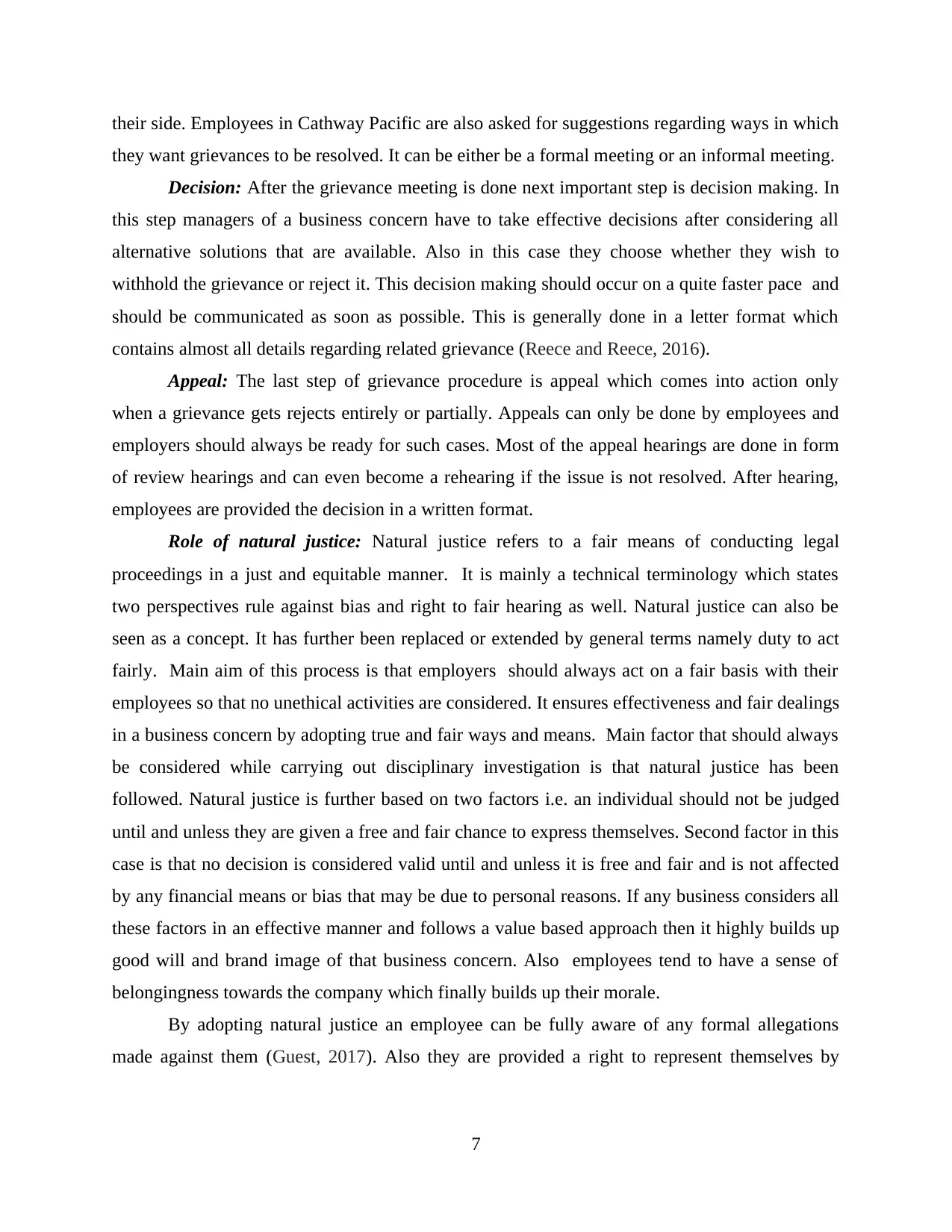
their side. Employees in Cathway Pacific are also asked for suggestions regarding ways in which
they want grievances to be resolved. It can be either be a formal meeting or an informal meeting.
Decision: After the grievance meeting is done next important step is decision making. In
this step managers of a business concern have to take effective decisions after considering all
alternative solutions that are available. Also in this case they choose whether they wish to
withhold the grievance or reject it. This decision making should occur on a quite faster pace and
should be communicated as soon as possible. This is generally done in a letter format which
contains almost all details regarding related grievance (Reece and Reece, 2016).
Appeal: The last step of grievance procedure is appeal which comes into action only
when a grievance gets rejects entirely or partially. Appeals can only be done by employees and
employers should always be ready for such cases. Most of the appeal hearings are done in form
of review hearings and can even become a rehearing if the issue is not resolved. After hearing,
employees are provided the decision in a written format.
Role of natural justice: Natural justice refers to a fair means of conducting legal
proceedings in a just and equitable manner. It is mainly a technical terminology which states
two perspectives rule against bias and right to fair hearing as well. Natural justice can also be
seen as a concept. It has further been replaced or extended by general terms namely duty to act
fairly. Main aim of this process is that employers should always act on a fair basis with their
employees so that no unethical activities are considered. It ensures effectiveness and fair dealings
in a business concern by adopting true and fair ways and means. Main factor that should always
be considered while carrying out disciplinary investigation is that natural justice has been
followed. Natural justice is further based on two factors i.e. an individual should not be judged
until and unless they are given a free and fair chance to express themselves. Second factor in this
case is that no decision is considered valid until and unless it is free and fair and is not affected
by any financial means or bias that may be due to personal reasons. If any business considers all
these factors in an effective manner and follows a value based approach then it highly builds up
good will and brand image of that business concern. Also employees tend to have a sense of
belongingness towards the company which finally builds up their morale.
By adopting natural justice an employee can be fully aware of any formal allegations
made against them (Guest, 2017). Also they are provided a right to represent themselves by
7
they want grievances to be resolved. It can be either be a formal meeting or an informal meeting.
Decision: After the grievance meeting is done next important step is decision making. In
this step managers of a business concern have to take effective decisions after considering all
alternative solutions that are available. Also in this case they choose whether they wish to
withhold the grievance or reject it. This decision making should occur on a quite faster pace and
should be communicated as soon as possible. This is generally done in a letter format which
contains almost all details regarding related grievance (Reece and Reece, 2016).
Appeal: The last step of grievance procedure is appeal which comes into action only
when a grievance gets rejects entirely or partially. Appeals can only be done by employees and
employers should always be ready for such cases. Most of the appeal hearings are done in form
of review hearings and can even become a rehearing if the issue is not resolved. After hearing,
employees are provided the decision in a written format.
Role of natural justice: Natural justice refers to a fair means of conducting legal
proceedings in a just and equitable manner. It is mainly a technical terminology which states
two perspectives rule against bias and right to fair hearing as well. Natural justice can also be
seen as a concept. It has further been replaced or extended by general terms namely duty to act
fairly. Main aim of this process is that employers should always act on a fair basis with their
employees so that no unethical activities are considered. It ensures effectiveness and fair dealings
in a business concern by adopting true and fair ways and means. Main factor that should always
be considered while carrying out disciplinary investigation is that natural justice has been
followed. Natural justice is further based on two factors i.e. an individual should not be judged
until and unless they are given a free and fair chance to express themselves. Second factor in this
case is that no decision is considered valid until and unless it is free and fair and is not affected
by any financial means or bias that may be due to personal reasons. If any business considers all
these factors in an effective manner and follows a value based approach then it highly builds up
good will and brand image of that business concern. Also employees tend to have a sense of
belongingness towards the company which finally builds up their morale.
By adopting natural justice an employee can be fully aware of any formal allegations
made against them (Guest, 2017). Also they are provided a right to represent themselves by
7
⊘ This is a preview!⊘
Do you want full access?
Subscribe today to unlock all pages.

Trusted by 1+ million students worldwide
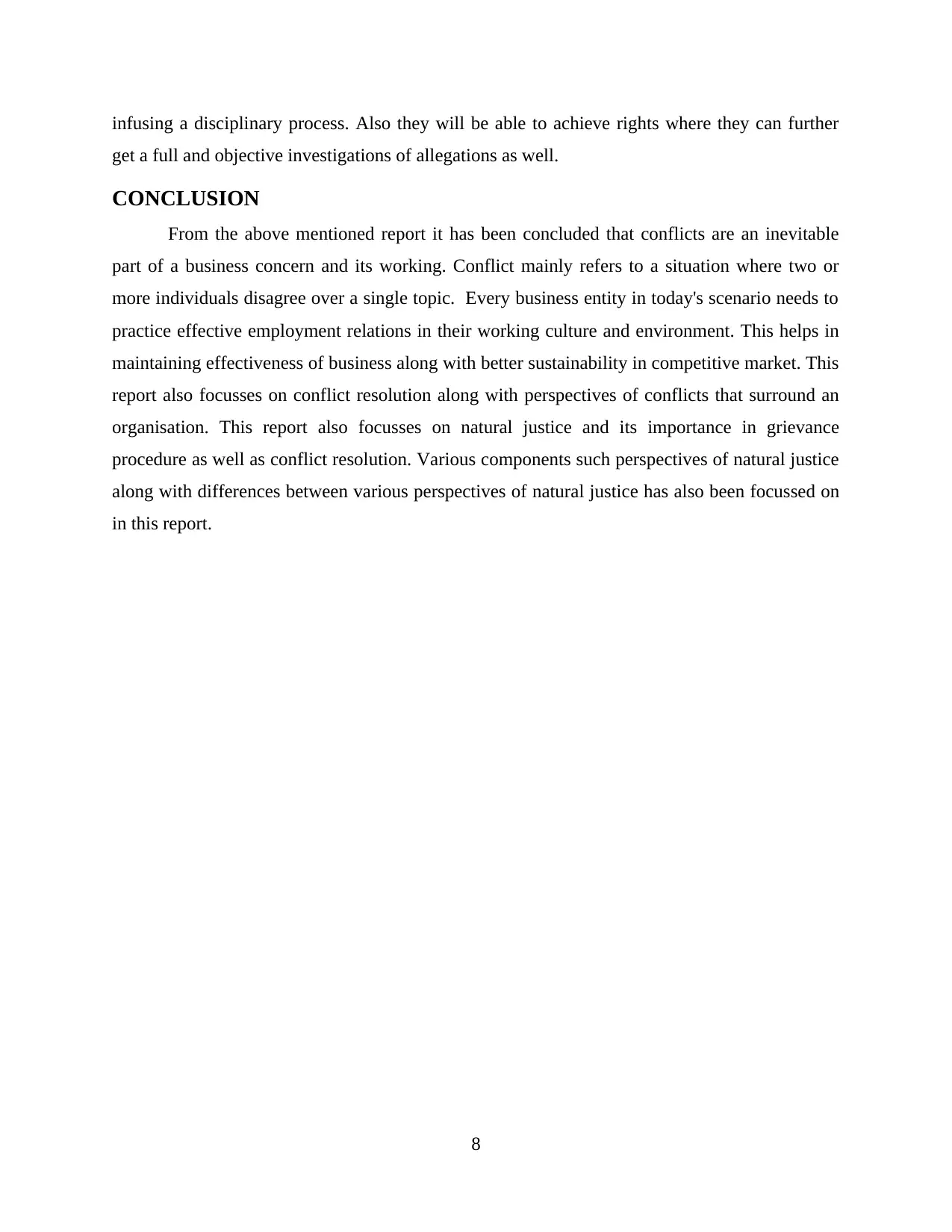
infusing a disciplinary process. Also they will be able to achieve rights where they can further
get a full and objective investigations of allegations as well.
CONCLUSION
From the above mentioned report it has been concluded that conflicts are an inevitable
part of a business concern and its working. Conflict mainly refers to a situation where two or
more individuals disagree over a single topic. Every business entity in today's scenario needs to
practice effective employment relations in their working culture and environment. This helps in
maintaining effectiveness of business along with better sustainability in competitive market. This
report also focusses on conflict resolution along with perspectives of conflicts that surround an
organisation. This report also focusses on natural justice and its importance in grievance
procedure as well as conflict resolution. Various components such perspectives of natural justice
along with differences between various perspectives of natural justice has also been focussed on
in this report.
8
get a full and objective investigations of allegations as well.
CONCLUSION
From the above mentioned report it has been concluded that conflicts are an inevitable
part of a business concern and its working. Conflict mainly refers to a situation where two or
more individuals disagree over a single topic. Every business entity in today's scenario needs to
practice effective employment relations in their working culture and environment. This helps in
maintaining effectiveness of business along with better sustainability in competitive market. This
report also focusses on conflict resolution along with perspectives of conflicts that surround an
organisation. This report also focusses on natural justice and its importance in grievance
procedure as well as conflict resolution. Various components such perspectives of natural justice
along with differences between various perspectives of natural justice has also been focussed on
in this report.
8
Paraphrase This Document
Need a fresh take? Get an instant paraphrase of this document with our AI Paraphraser
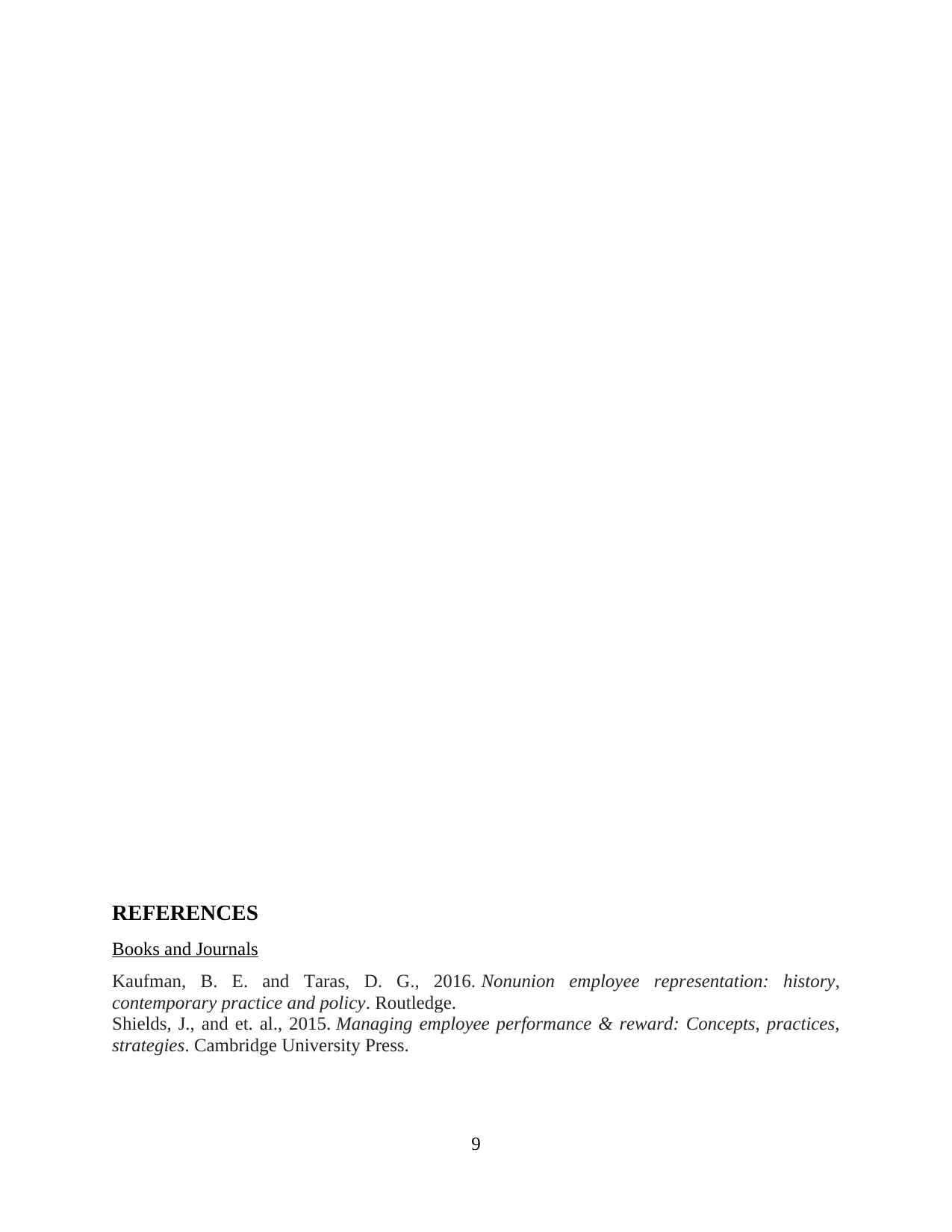
REFERENCES
Books and Journals
Kaufman, B. E. and Taras, D. G., 2016. Nonunion employee representation: history,
contemporary practice and policy. Routledge.
Shields, J., and et. al., 2015. Managing employee performance & reward: Concepts, practices,
strategies. Cambridge University Press.
9
Books and Journals
Kaufman, B. E. and Taras, D. G., 2016. Nonunion employee representation: history,
contemporary practice and policy. Routledge.
Shields, J., and et. al., 2015. Managing employee performance & reward: Concepts, practices,
strategies. Cambridge University Press.
9
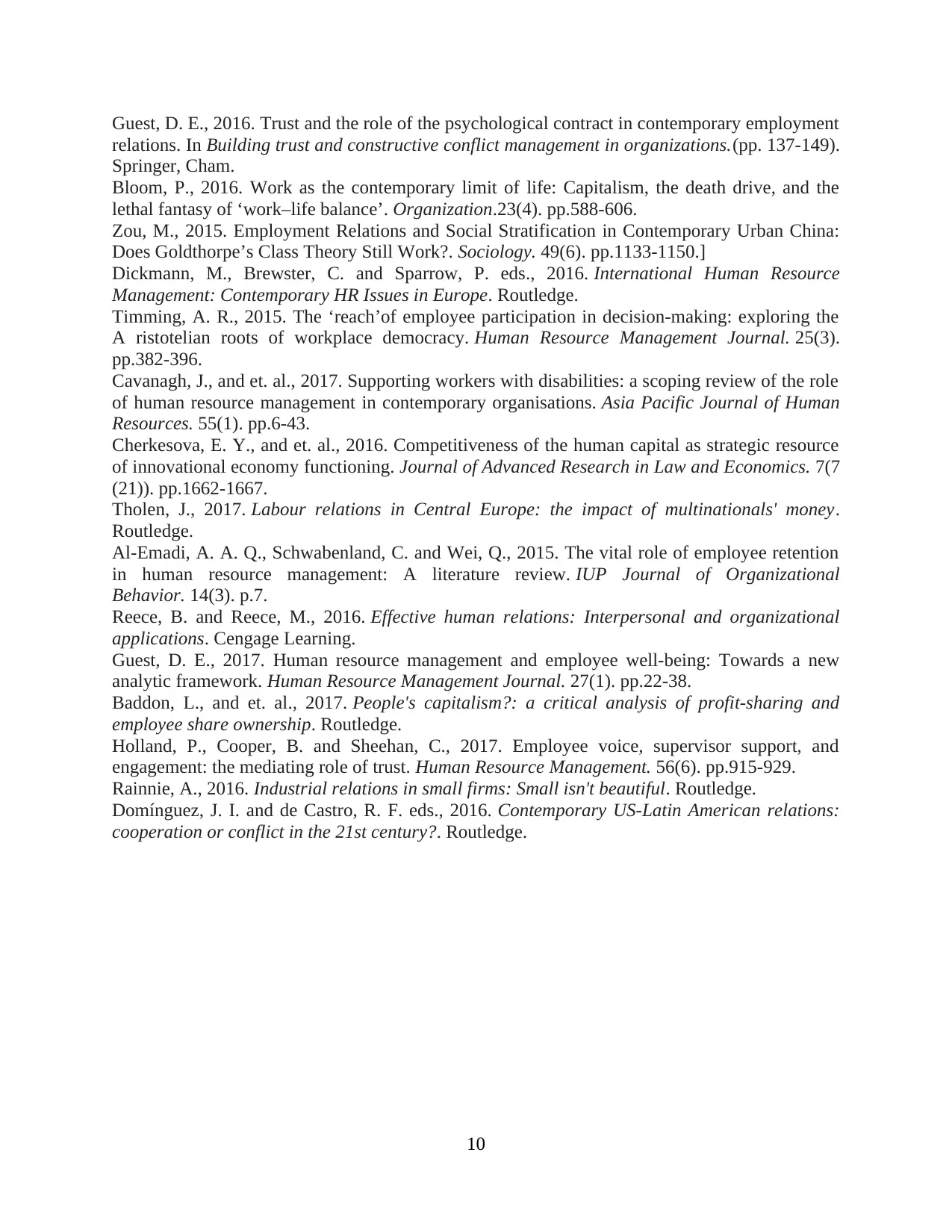
Guest, D. E., 2016. Trust and the role of the psychological contract in contemporary employment
relations. In Building trust and constructive conflict management in organizations.(pp. 137-149).
Springer, Cham.
Bloom, P., 2016. Work as the contemporary limit of life: Capitalism, the death drive, and the
lethal fantasy of ‘work–life balance’. Organization.23(4). pp.588-606.
Zou, M., 2015. Employment Relations and Social Stratification in Contemporary Urban China:
Does Goldthorpe’s Class Theory Still Work?. Sociology. 49(6). pp.1133-1150.]
Dickmann, M., Brewster, C. and Sparrow, P. eds., 2016. International Human Resource
Management: Contemporary HR Issues in Europe. Routledge.
Timming, A. R., 2015. The ‘reach’of employee participation in decision‐making: exploring the
A ristotelian roots of workplace democracy. Human Resource Management Journal. 25(3).
pp.382-396.
Cavanagh, J., and et. al., 2017. Supporting workers with disabilities: a scoping review of the role
of human resource management in contemporary organisations. Asia Pacific Journal of Human
Resources. 55(1). pp.6-43.
Cherkesova, E. Y., and et. al., 2016. Competitiveness of the human capital as strategic resource
of innovational economy functioning. Journal of Advanced Research in Law and Economics. 7(7
(21)). pp.1662-1667.
Tholen, J., 2017. Labour relations in Central Europe: the impact of multinationals' money.
Routledge.
Al-Emadi, A. A. Q., Schwabenland, C. and Wei, Q., 2015. The vital role of employee retention
in human resource management: A literature review. IUP Journal of Organizational
Behavior. 14(3). p.7.
Reece, B. and Reece, M., 2016. Effective human relations: Interpersonal and organizational
applications. Cengage Learning.
Guest, D. E., 2017. Human resource management and employee well‐being: Towards a new
analytic framework. Human Resource Management Journal. 27(1). pp.22-38.
Baddon, L., and et. al., 2017. People's capitalism?: a critical analysis of profit-sharing and
employee share ownership. Routledge.
Holland, P., Cooper, B. and Sheehan, C., 2017. Employee voice, supervisor support, and
engagement: the mediating role of trust. Human Resource Management. 56(6). pp.915-929.
Rainnie, A., 2016. Industrial relations in small firms: Small isn't beautiful. Routledge.
Domínguez, J. I. and de Castro, R. F. eds., 2016. Contemporary US-Latin American relations:
cooperation or conflict in the 21st century?. Routledge.
10
relations. In Building trust and constructive conflict management in organizations.(pp. 137-149).
Springer, Cham.
Bloom, P., 2016. Work as the contemporary limit of life: Capitalism, the death drive, and the
lethal fantasy of ‘work–life balance’. Organization.23(4). pp.588-606.
Zou, M., 2015. Employment Relations and Social Stratification in Contemporary Urban China:
Does Goldthorpe’s Class Theory Still Work?. Sociology. 49(6). pp.1133-1150.]
Dickmann, M., Brewster, C. and Sparrow, P. eds., 2016. International Human Resource
Management: Contemporary HR Issues in Europe. Routledge.
Timming, A. R., 2015. The ‘reach’of employee participation in decision‐making: exploring the
A ristotelian roots of workplace democracy. Human Resource Management Journal. 25(3).
pp.382-396.
Cavanagh, J., and et. al., 2017. Supporting workers with disabilities: a scoping review of the role
of human resource management in contemporary organisations. Asia Pacific Journal of Human
Resources. 55(1). pp.6-43.
Cherkesova, E. Y., and et. al., 2016. Competitiveness of the human capital as strategic resource
of innovational economy functioning. Journal of Advanced Research in Law and Economics. 7(7
(21)). pp.1662-1667.
Tholen, J., 2017. Labour relations in Central Europe: the impact of multinationals' money.
Routledge.
Al-Emadi, A. A. Q., Schwabenland, C. and Wei, Q., 2015. The vital role of employee retention
in human resource management: A literature review. IUP Journal of Organizational
Behavior. 14(3). p.7.
Reece, B. and Reece, M., 2016. Effective human relations: Interpersonal and organizational
applications. Cengage Learning.
Guest, D. E., 2017. Human resource management and employee well‐being: Towards a new
analytic framework. Human Resource Management Journal. 27(1). pp.22-38.
Baddon, L., and et. al., 2017. People's capitalism?: a critical analysis of profit-sharing and
employee share ownership. Routledge.
Holland, P., Cooper, B. and Sheehan, C., 2017. Employee voice, supervisor support, and
engagement: the mediating role of trust. Human Resource Management. 56(6). pp.915-929.
Rainnie, A., 2016. Industrial relations in small firms: Small isn't beautiful. Routledge.
Domínguez, J. I. and de Castro, R. F. eds., 2016. Contemporary US-Latin American relations:
cooperation or conflict in the 21st century?. Routledge.
10
⊘ This is a preview!⊘
Do you want full access?
Subscribe today to unlock all pages.

Trusted by 1+ million students worldwide
1 out of 12
Related Documents
Your All-in-One AI-Powered Toolkit for Academic Success.
+13062052269
info@desklib.com
Available 24*7 on WhatsApp / Email
![[object Object]](/_next/static/media/star-bottom.7253800d.svg)
Unlock your academic potential
Copyright © 2020–2025 A2Z Services. All Rights Reserved. Developed and managed by ZUCOL.





